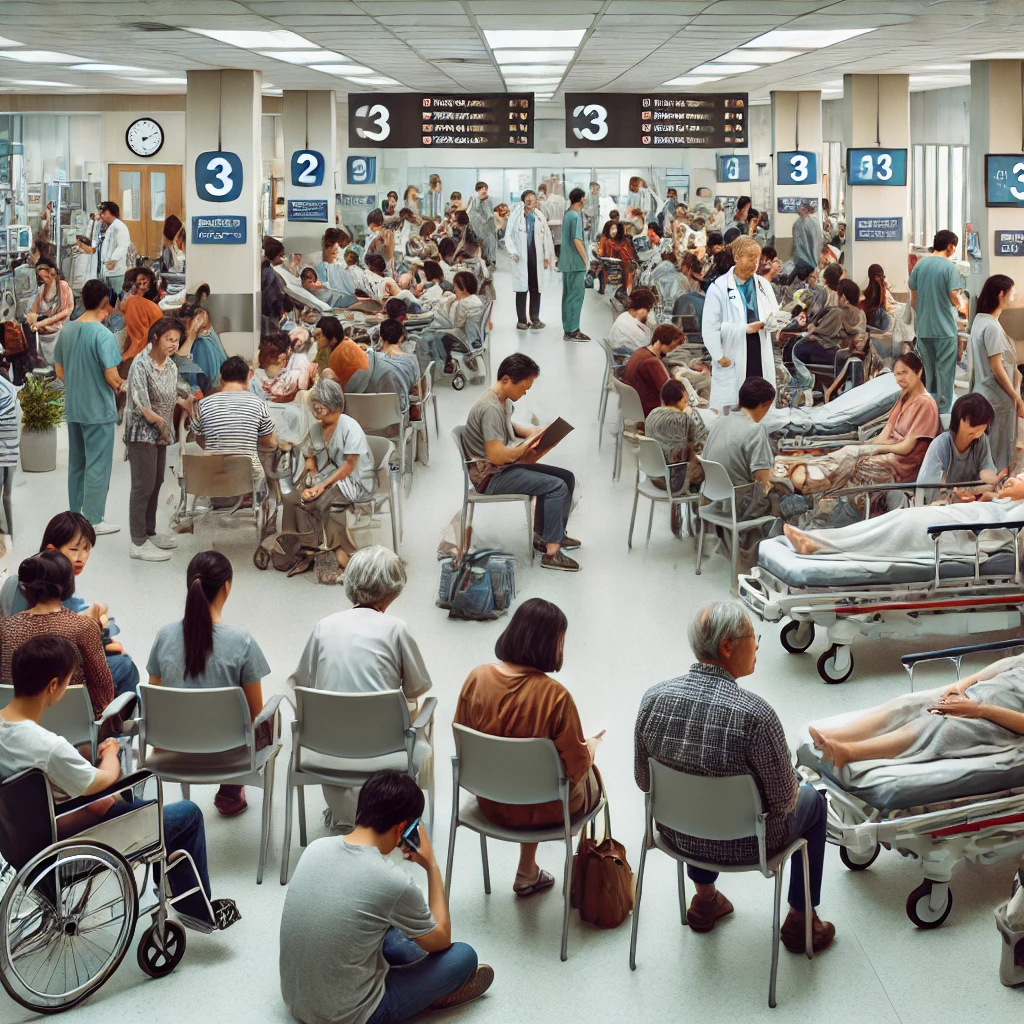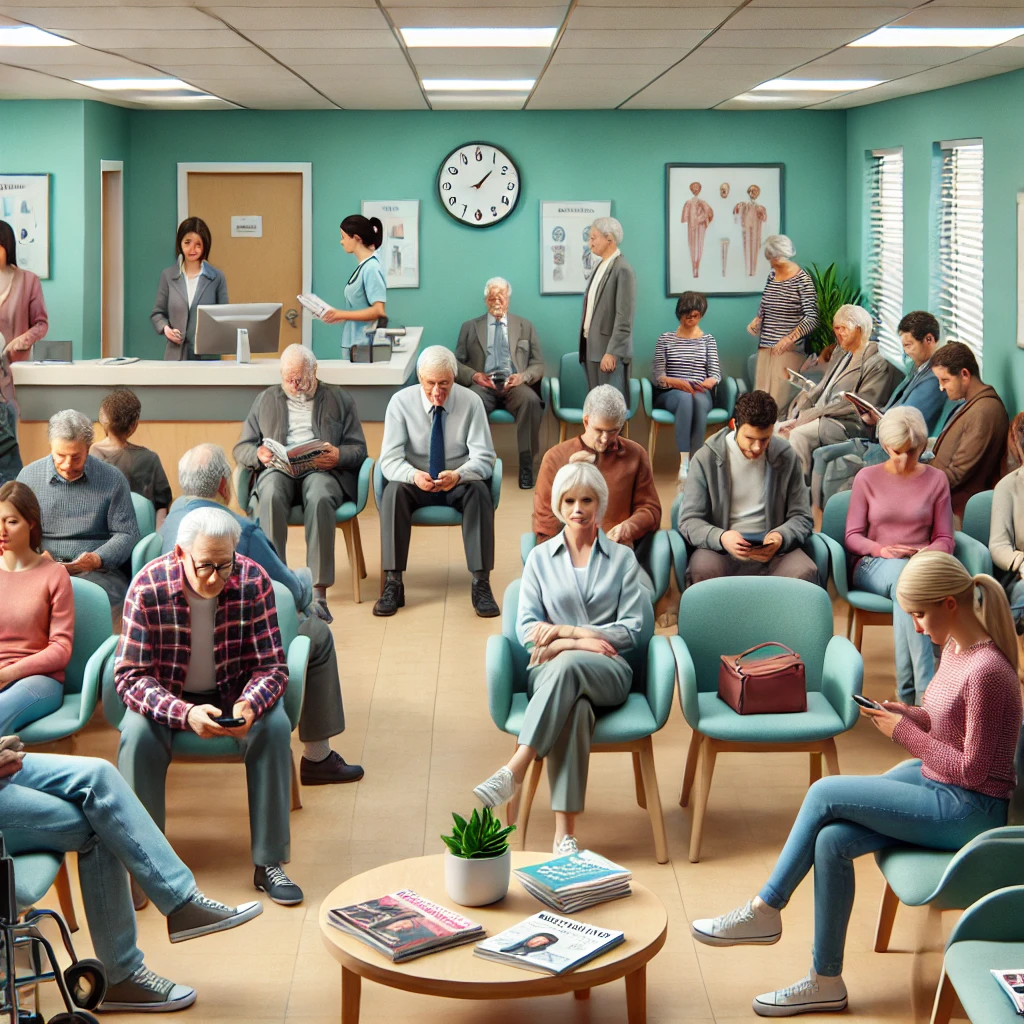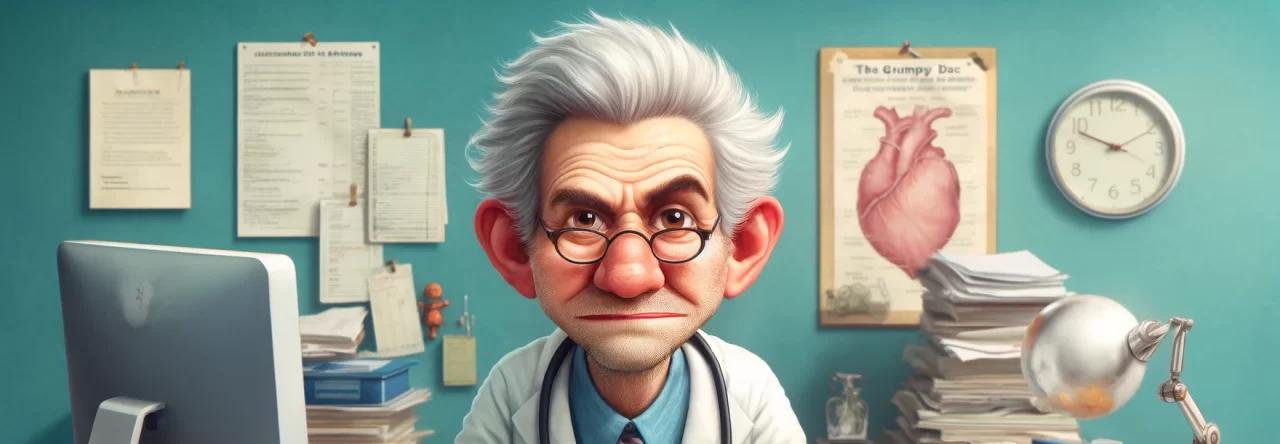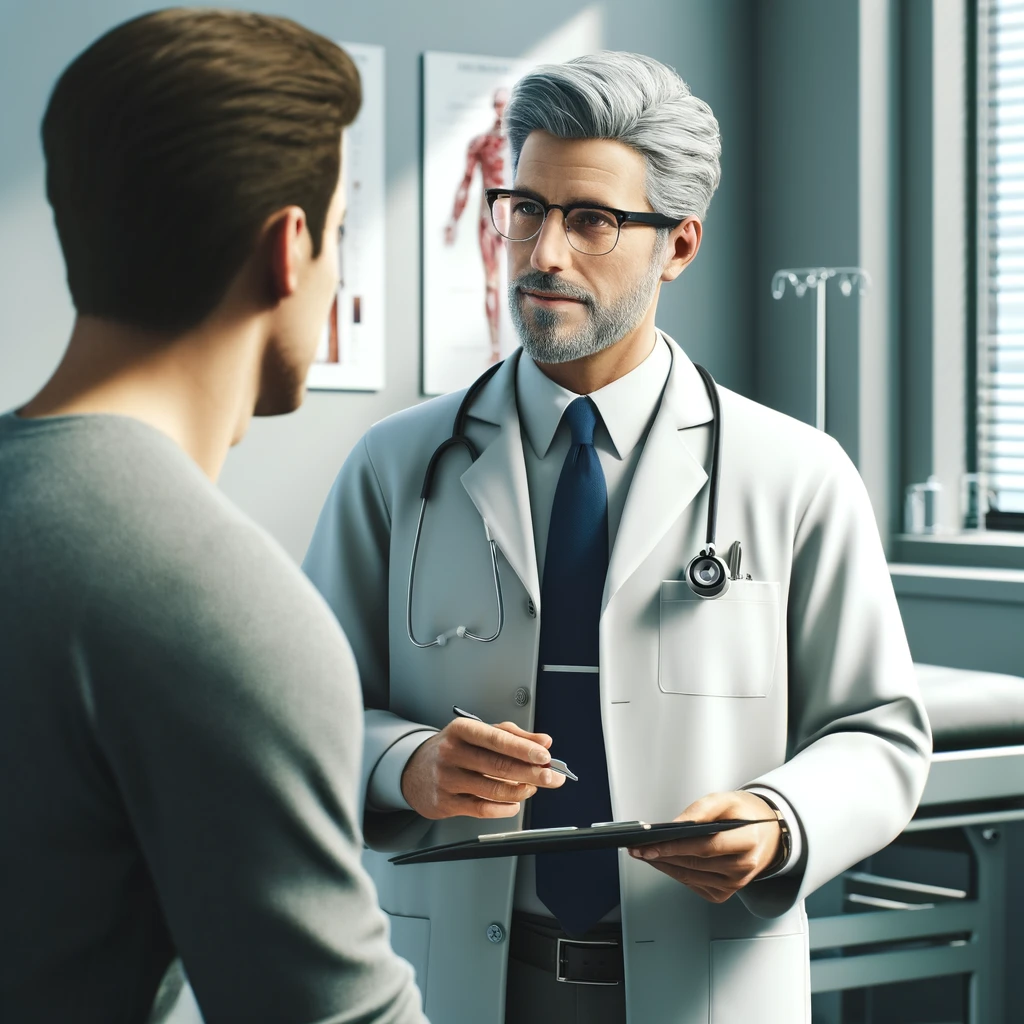
Introduction
Yes, it’s hard waiting in this room. I get it, I really do! After many years as an emergency doc I really understand what it’s like for you to be waiting for treatment for yourself or family members. It’s particularly stressful during the holiday season when emergency departments are crowded and no one wants to inconvenience family or friends by having to make a trip to the hospital. I have spent quite a few Christmases in the emergency department, so I’ve seen first hand how difficult it can be for patients and families to try to celebrate their holidays in the hospital. (By the way, that’s me in the white coat.)
If you do need to go to the emergency department, be sure and check in with the triage nurse soon as you get there. Give as detailed a description of your symptoms as possible. The more information you provide, the better job the nurse can do of triaging you. Triage is method that emergency departments use to determine who needs to be seen first. It’s not first come first served. If at any time your symptoms change during your stay, you need to immediately notify the nurse.
During the holiday season emergency departments are frequently over crowded and under staffed. This can lead to long delays. If at all possible you should have someone with you in case you do start having problems they can immediately notify the nursing staff for you.
A word of caution. There is a common misconception that taking an ambulance will get you to the head of the line. This is not true. Even if you arrive by ambulance, if your initial assessment does not indicate an emergent condition, you may be triaged to the waiting room. Additionally, your insurance company may refuse to cover the ambulance trip for a non emergent condition.
Now, here’s the big but… A lot of people delay seeking medical care during the holiday season with sometimes disastrous results. Below are 10 reasons that you should seek medical care at any time and particularly during the stressful holiday season.
1. Chest Pain
- Symptoms: Pressure, tightness, or discomfort in the chest, which may radiate to the arms, back, neck, or jaw, often accompanied by shortness of breath, excessive sweating, or nausea. Women and diabetics may experience milder symptoms, such as isolated fatigue, dizziness, or nausea, and should maintain a high degree of suspicion.
- Potential Outcomes If Ignored: Chest pain could signal a heart attack, potentially leading to heart muscle damage, heart failure, or death if not treated promptly.
- Action: Seek emergency care. Call 911 or visit an emergency department (ED) immediately, as timely intervention can be life-saving. Contact your PCP for chest pain primarily in the chest wall, especially if it worsens with coughing or movement.
2. Severe Shortness of Breath
- Symptoms: Difficulty breathing, wheezing, gasping for air, or an inability to catch your breath.
- Potential Outcomes If Ignored: Severe shortness of breath could indicate conditions like asthma, pneumonia, pulmonary embolism, or heart failure. If untreated, it may lead to respiratory failure or sudden death.
- Action: Seek emergency care immediately. Severe shortness of breath requires prompt evaluation in the ED to determine the cause and provide necessary treatments. Mild shortness of breath with activity or when lying flat should be assessed by your PCP.
3. Sudden Weakness, Numbness, or Difficulty Speaking
- Symptoms: Sudden loss of strength or sensation, particularly on only one side of the body, difficulty speaking, confusion, or trouble walking or holding objects.
- Potential Outcomes If Ignored: These symptoms often indicate a stroke. Without prompt treatment, brain damage can occur quickly, leading to permanent disability or death. If the symptoms resolve on their own, it could be a transient ischemic attack (TIA), a warning sign of an impending stroke.
- Action: Seek emergency care. Call 911 immediately. Early treatment can significantly improve recovery outcomes. Do not ignore TIA symptoms, as a stroke may follow shortly.
4. Severe Abdominal Pain
- Symptoms: Sharp or intense pain in the stomach area, often accompanied by nausea, vomiting, or fever.
- Potential Outcomes If Ignored: Severe abdominal pain could indicate appendicitis, bowel obstruction, or gallbladder disease. Untreated, these conditions can lead to infections or organ damage.
- Action: Seek emergency care for sudden, intense pain. For persistent but less severe pain, contact your PCP for evaluation.
5. High Fever with Severe Symptoms
- Symptoms: A fever over 103°F (39.4°C), especially if accompanied by confusion, headache, weakness, dizziness, stiff neck, rash, or difficulty breathing.
- Potential Outcomes If Ignored: High fever with severe symptoms may indicate serious infections like meningitis or sepsis, which can rapidly become life-threatening.
- Action: Seek emergency care for high fevers with concerning symptoms. For lower but persistent fevers, consult your PCP.
6. Persistent Cough or Coughing Up Blood
- Symptoms: A cough lasting more than three weeks, wheezing, or producing blood-streaked mucus.
- Potential Outcomes If Ignored: A chronic cough could be a sign of lung infections like pneumonia, chronic obstructive pulmonary disease (COPD), or even lung cancer. Coughing up blood may indicate a severe infection or pulmonary embolism.
- Action: Contact your PCP for a persistent cough. Seek emergency care if you are coughing up blood or experiencing severe symptoms like high fever or shortness of breath.
7. Severe Allergic Reaction (Anaphylaxis)
- Symptoms: Swelling of the throat, lips, or tongue; difficulty breathing; rapid heartbeat; or dizziness following exposure to an allergen.
- Potential Outcomes If Ignored: Anaphylaxis can be life-threatening if not treated immediately, potentially leading to shock or death.
- Action: Seek emergency care. Use an epinephrine auto-injector if available and call 911 or go to the ED right away.
8. Sudden, Severe Headache
- Symptoms: Intense headache that comes on suddenly, often described as the “worst headache of your life”, sometimes accompanied by vomiting or visual changes.
- Potential Outcomes If Ignored: A sudden, severe headache could indicate a brain aneurysm or stroke. Ignoring these symptoms may result in brain damage or death.
- Action: Seek emergency care. Immediate attention is necessary, especially if the headache is accompanied by neurological symptoms like weakness or vision changes.
9. Sudden Vision Loss or Changes
- Symptoms: Sudden blurred vision, double vision, or complete or partial loss of vision in one or both eyes.
- Potential Outcomes If Ignored: Sudden vision changes may indicate retinal detachment, stroke, or another neurological issue. Without treatment, permanent vision loss or brain damage can occur.
- Action: Seek emergency care if vision loss is sudden or accompanied by other symptoms like headache or weakness. For gradual vision changes, consult your PCP or an ophthalmologist.
10. Unexplained Weight Loss or Fatigue
- Symptoms: Significant, unintended weight loss or extreme fatigue persisting without a clear cause.
- Potential Outcomes If Ignored: Unexplained weight loss or fatigue could signal serious underlying conditions such as cancer, diabetes, thyroid disorders, or depression. Delayed diagnosis and treatment may lead to worsening health.
- Action: Contact your PCP. While not usually an emergency, a comprehensive evaluation is needed to identify and address the underlying cause.
Conclusion
Recognizing when to seek medical attention can be life-saving. For severe, sudden symptoms like chest pain, shortness of breath, or signs of a stroke, emergency care is essential. For more gradual or less urgent issues, your primary care physician can provide diagnosis, guidance, and treatment. Don’t wait—early intervention often prevents serious complications down the road.














The Harmful Grip of Cigarette Smoking
By John Turley
On October 24, 2024
In Commentary, Medicine
Addiction, Health Risks, and the Benefits of Quitting
Cigarette smoking remains one of the leading causes of preventable death worldwide. In the more than 65 years since the US Surgeon General first required health warnings to be placed on cigarette packs, significant progress has been made in reducing the rates of smoking. In 1965 about 45% of US adults were smokers and today fewer than 12% smoke on a regular basis. Youth smoking rates have also declined dramatically. In recent years fewer than 5% of high school students report smoking on a regular basis. In my high school class (1966) the smoking rate was probably closer to 30%. As encouraging as these numbers are, there is no acceptable rate of smoking, and I hope those of you who don’t smoke will pass this article on to family or friends who do.
The Power of Nicotine Addiction
Nicotine, the primary addictive substance in cigarettes, is remarkably potent. When inhaled, it travels to the brain within seconds, where it stimulates the release of dopamine, a neurotransmitter that creates a feeling of pleasure and relaxation. Over time, the brain rewires itself, craving nicotine to maintain these pleasurable effects, leading to dependency.
The addictive nature of nicotine makes quitting extremely difficult, as withdrawal symptoms, including irritability, anxiety, difficulty concentrating, and intense cravings, can deter many smokers from quitting. Nicotine also increases heart rate and blood pressure, contributing to the stress-relief paradox: although many smokers feel cigarettes help them relax, the substance actually exacerbates stress on the cardiovascular system.
Smoking can be tied to our daily routines. Some people have commonly have a cigarette with morning coffee or after meals. Other people reach for a cigarette when they’re on the telephone. Social settings and peer influence can make quitting difficult. Attending social gatherings where smoking is common can reignite cravings. A smoker who decides to quit can feel surrounded by the temptations to resume smoking.
There are a number of other factors also that make it difficult to quit smoking. There’s a lack of immediate health benefits noted. Improvements like better lung function, reduced cancer risk or long terms outcomes are not noted right away. Some smokers fear weight gain more than they fear the effects of smoking and will delay any attempts at cessation because of that. Some smokers also feel frustration because after a few days without a cigarette they think “I don’t feel any better, what’s the point?”
Health Risks: Nicotine and Smoke by-products
Cigarette smoke contains over 7,000 chemicals, many of which are toxic. Among these are tar, carbon monoxide, formaldehyde, and heavy metals like cadmium and lead. Some chemicals are carcinogens, contributing to the development of cancer, while others damage tissues and organs in less visible but no less harmful ways.
The Benefits of Quitting Smoking
It’s never too late to quit smoking, and the benefits begin almost immediately after quitting.
The Deceptive Appeal of Vaping
Unfortunately, the rise of e-cigarettes, also known as vaping, has emerged as an alternative to smoking among many people. E-cigarettes deliver nicotine through vapor rather than smoke. While they eliminate some of the harmful byproducts like tar and carbon monoxide, vaping is not without risks. Some vaping products contain toxic materials not contained in tobacco. Especially custom or self-blended cartridges for vape pens that may have carcinogenic or otherwise harmful additives not readily obvious to the user. Unfortunately, many adolescents and young adults who have never smoked cigarettes have developed a nicotine addiction through e-cigarette use.
Conclusion
There is no safe level of use of tobacco or other forms of nicotine. Quitting smoking improves quality of life, reducing the frequency of respiratory infections and improving overall energy levels. For long-time smokers, the prospect of reversing years of damage may seem daunting, but research consistently shows that health outcomes improve at any point, even decades after quitting. If I could give my smoking patients only one piece of medical advice it would be: “Quit smoking and quit now”. And I know how hard it is. I quit smoking 53 years ago and for many years afterwards it remained a daily struggle. But eventually, with the help and support of my family I was able to get past my tobacco cravings.